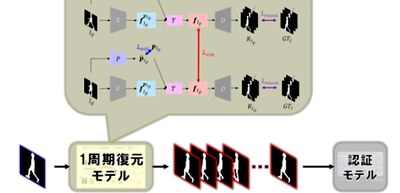
Making gait recognition from a single image possible using deep learning techniques
A research group from Osaka University’s SANKEN (The Institute of Scientific and Industrial Research) developed a unified framework of a phase-aware gait cycle reconstruction network (PA-GCRNet) for gait recognition from a single image.
Biometrics such as gait has been used for criminal investigation using footage from surveillance cameras. Conventional gait recognition used images of a full gait cycle (or about one second for one full left and right gait cycle). However, in addition to capture latency, gait recognition from a single image was difficult when the entire body of a person could only be captured for a brief moment. Thus, a gait recognition method using a single input image was not able to guarantee optimal recognition accuracy.
In this study, the group developed a phase-aware gait cycle reconstructor (PA-GCR), a deep learning model that reconstructs full gait cycles of image sequences from single images while predicting a phase (gait pose).
The framework consists of the PA-GCR module and a subsequent recognition network (PA-GCRNet). Instead of simply minimizing the gait cycle reconstruction error, PA-GCRNet, which is based on deep learning, learns an appropriate gait cycle reconstruction, where the network parameters are shared. Thus, the reconstruction quality is well-maintained while simultaneously ensuring optimal recognition performance.
They verified the effectiveness of the proposed unified framework using publicly available gait datasets including some 10,000 subjects. For 5,000 subjects, the equal error rate (EER) was reduced to about 1/15 of that of conventional methods, improving the rank-1 identification rate (or the rate at which the correct individual has the highest match score) to over five times higher than that of the benchmarks.
The framework developed by this group can be used as a gait recognition method for various purposes, such as gait recognition from a snapshot in walking, crime prevention, and surveillance in crowded environments where an individual's entire body can be captured only for a moment, as well as real-time access control.
Figure 1
The results of this research were presented at the 16th European Conference on Computer Vision (ECCV) 2020 held from August 23 through August 28, 2020.

